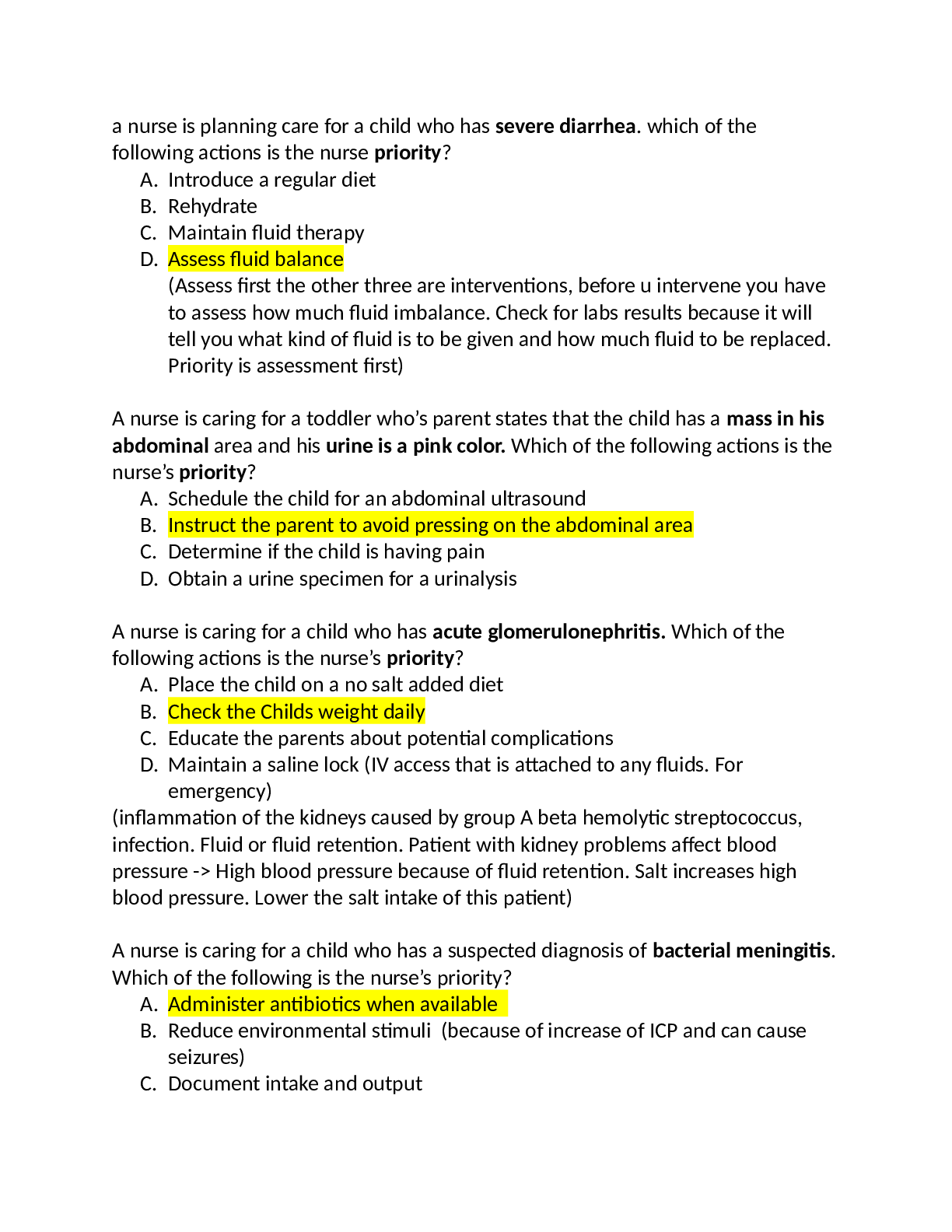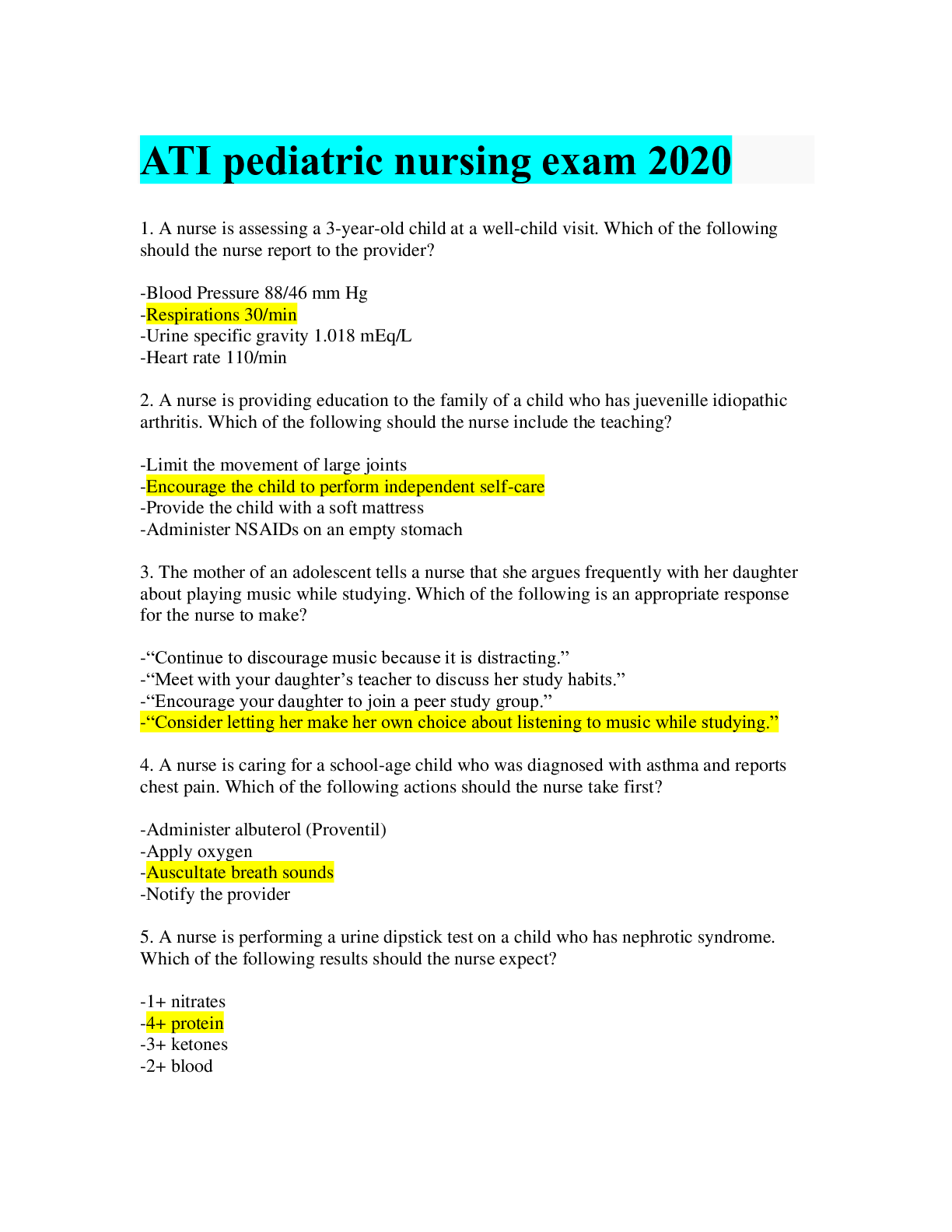*NURSING > QUESTIONS and ANSWERS > ATI Adult Nursing (NUR 105) Med Surg Test Questions and Answers with Explanations Chapter 21 Respira (All)
ATI Adult Nursing (NUR 105) Med Surg Test Questions and Answers with Explanations Chapter 21 Respiratory Care Modalities
Document Content and Description Below
ATI Adult Nursing (NUR 105) Med Surg Test Questions and Answers with Explanations Chapter 21 Respiratory Care Modalities 1. The nurse is caring for a patient with chronic obstructive pulmonary diseas... e (COPD). The patient has been receiving high-flow oxygen therapy for an extended time. What symptoms should the nurse anticipate if the patient were experiencing oxygen toxicity? a. Bradycardia and frontal headache b. Dyspnea and substernal pain c. Peripheral cyanosis and restlessness d. Hypotension and tachycardia Ans: B Feedback: Oxygen toxicity can occur when patients receive too high a concentration of oxygen for an extended period. Symptoms of oxygen toxicity include dyspnea, substernal pain, restlessness, fatigue, and progressive respiratory difficulty. Bradycardia, frontal headache, cyanosis, hypotension, and tachycardia are not symptoms of oxygen toxicity. 2. The nurse caring for a patient with an endotracheal tube recognizes several disadvantages of an endotracheal tube. What would the nurse recognize as a disadvantage of endotracheal tubes? a. Cognition is decreased. b. Daily arterial blood gases (ABGs) are necessary. c. Slight tracheal bleeding is anticipated. d. The cough reflex is depressed. Ans: D Feedback: There are several disadvantages of an endotracheal tube. Disadvantages include suppression of the patients cough reflex, thickening of secretions, and depressed swallowing reflexes. Ulceration and stricture of the larynx or trachea may develop, but bleeding is not an expected finding. The tube should not influence cognition and daily ABGs are not always required. 3. What would the critical care nurse recognize as a condition that may indicate a patients need to have a tracheostomy? a. A patient has a respiratory rate of 10 breaths per minute.b. A patient requires permanent ventilation. c. A patient exhibits symptoms of dyspnea. d. A patient has respiratory acidosis. Ans: B Feedback: A tracheostomy permits long-term use of mechanical ventilation to prevent aspiration of oral and gastric secretions in the unconscious or paralyzed patient. Indications for a tracheostomy do not include a respiratory rate of 10 breaths per minute, symptoms of dyspnea, or respiratory acidosis. [Show More]
Last updated: 2 years ago
Preview 1 out of 18 pages
 Med Surg Test Questions and Answers with Explanations Chapter 21 Respiratory Care Modalities.png)
Buy this document to get the full access instantly
Instant Download Access after purchase
Buy NowInstant download
We Accept:

Reviews( 0 )
$10.00
Can't find what you want? Try our AI powered Search
Document information
Connected school, study & course
About the document
Uploaded On
Apr 30, 2021
Number of pages
18
Written in
Additional information
This document has been written for:
Uploaded
Apr 30, 2021
Downloads
0
Views
108

 Graded A.png)
 COMPREHENSIVE PREDICTOR ATI 1ST TAKE Questions and Answers with Complete Solutions.png)
.png)
.png)
.png)

, (A Grade), Questions and Answers, All Correct Study Guide, Download to Score A.png)
, (A Grade), Questions and Answers, All Correct Study Guide, Download to Score A.png)
, (A Grade), Questions and Answers, All Correct Study Guide, Download to Score A.png)
 EXAM REVIEW QUESTIONS AND ANSWERS WITH EXPLANATIONS GRADED A.png)
 EXAM REVIEW Questions and Answers.png)
 PROFESSIONAL NURSING CAPSTONE QUESTIONS AND ANSWERS.png)









 – Miami Dade College.png)
Perop.png)


